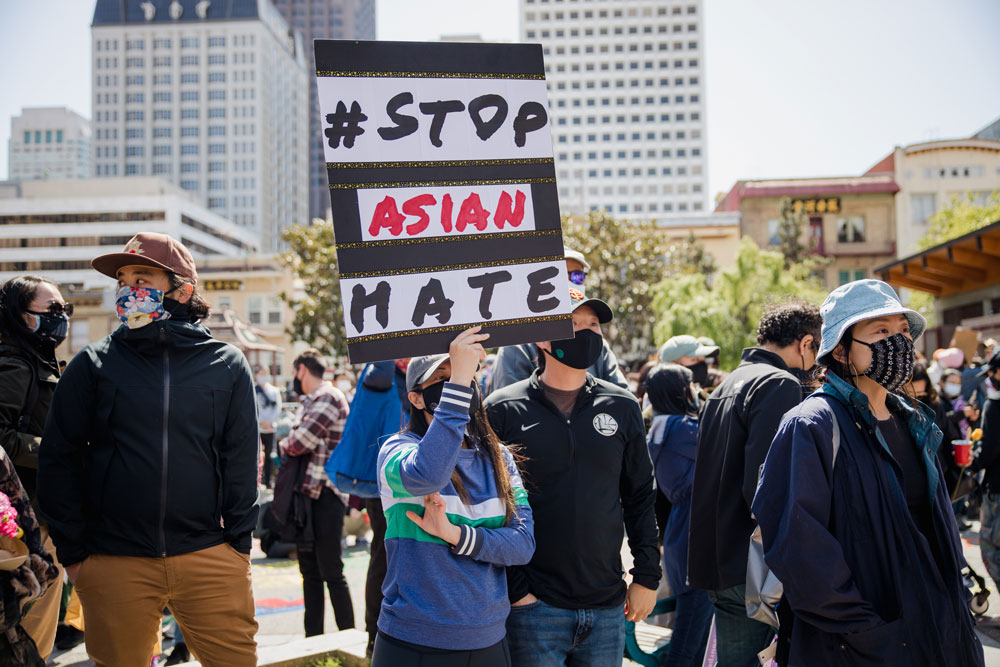
A new report from the Stop AAPI Hate coalition, Two Years and Thousands of Voices: What Community-Generated Data Tells Us About Anti-AAPI Hate, aims to provide a fuller picture of what members of the Asian American and Pacific Islander (AAPI) communities have experienced since the start of the COVID-19 pandemic.
Stop AAPI Hate began in 2020 at a time of rising anti-Asian violence in the US. The initiative was founded by three California-based organizations with deep roots in Asian American activism: the AAPI Equity Alliance (formerly known as the Asian Pacific Policy and Planning Council, or A3PCON), Chinese for Affirmative Action, and San Francisco State University’s Asian American Studies Department, which grew out of the 1968 Black Student Union/Third World Liberation Front Student Strike, leading to the country’s first College of Ethnic Studies.
The report discusses nearly 11,500 hate incidents reported to Stop AAPI Hate’s reporting center between March 19, 2020, and March 31, 2022. It also includes data from a national survey conducted in 2021 in partnership with Edelman Data & Intelligence.
Community Data Is Necessary for Understanding “Hate Incidents”
In February and March 2020, AAPI communities began to experience a surge of harassment, bullying, and other acts of hate—acts that were often accompanied by anti-China rhetoric that blamed AAPI people for the emerging COVID-19 pandemic. The three founding organizations mobilized quickly to collect information about these incidents. In the first week, the report notes, over 600 incidents were reported—within a month, that number ballooned to over 1,500.
Two years later, AAPI communities continue to experience elevated levels of harassment and violence in their everyday lives, including slurs, shunning, physical attacks, and other forms of discrimination. These incidents and media attention on physical attacks—particularly those on elders—have created a national atmosphere of fear.
Stop AAPI Hate reports on “hate incidents,” which it defines as “actions driven by bias against another person’s race, color, disability, religion, national origin, sexual orientation or gender identity.” This attention to a broad range of incidents is necessary because, as the report’s introduction notes, “the majority of hate incidents, though harmful and traumatic, do not meet the legal definition of a crime, and therefore require solutions beyond law enforcement.”
Such attention is also important for addressing racial violence. As Stop AAPI Hate co-founder and CAA co-executive director Cynthia Choi argued in a recent San Francisco Chronicle op-ed, “California can’t stop anti-Asian harassment if it doesn’t know it exists.” Stop AAPI Hate tries to create a more nuanced understanding of the experiences and impacts of anti-AAPI violence by tracking and reporting such incidents. Instead of relying solely on law enforcement or news reports, the initiative collected data directly from AAPI community members nationwide.
Looking for solutions beyond the carceral state also requires understanding the systemic causes of violence against Asian American and Pacific Islander communities.
A Closer Look at the Context Behind the Dataset
Policymaking, community organizing, and social services all require accurate data, but such data on AAPI communities is often limited. There is a need to collect more and better data about these communities to develop equitable policies and supports. Data inclusion is one way of combatting the social exclusion that renders AAPIs invisible in American public life—a key challenge for community power-building, as NPQ’s Cyndi Suarez has recently discussed.
Scholars and organizers have increasingly called for about Asians and Pacific Islanders to attend to significant differences (of national origin, ethnicity, language, religion, caste, class, immigration status, and more) and inequities within this racialized category. Without disaggregation, the AAPI community is conflated with its most visible and privileged members—a distortion that has contributed to and its weaponization against other communities of color in the US.
The Asia-Pacific region is home to 60 percent of the world’s population. It encompasses 63 countries, hundreds of ethnic groups, and thousands of languages. It includes China and India, the world’s two most populous countries, as well as several of the world’s smallest countries. As a racial category in the US, AAPI can refer to someone with origins in any of these lands, whether they are a sixth-generation Chinese American, a refugee from the US war on Afghanistan, or a US national from Guam. Despite such differences, AAPI communities have mobilized around shared experiences of racial exclusion in the US and histories of migration in response to colonial violence, labor exploitation, and war.
While many have noted that anti-Asian violence in the US isn’t new, historically, the social sector has ignored AAPI communities, and as a result, it has conducted little research to understand AAPI communities in the US—let alone community-led engaged research.
Given the limited data about AAPI communities, Stop AAPI Hate’s dataset is unique in a few ways. First, as previously noted, their dataset encompasses a broader category of hate incidents—and as a result, their reporting sheds light on the non-criminal incidents that comprise the majority of hate acts that AAPI communities regularly face. Second, by going beyond official statistics, the center’s reporting tool captures community members’ experiences in their own words. This provides researchers with qualitative information that the report describes as being “collected in partnership with communities, rather than on communities.”
Finally, and importantly, the dataset includes reports from community members with limited English proficiency or concerns about reporting to law enforcement. The Stop AAPI Hate reporting form is translated into 15 Asian and Pacific Islander languages other than English. The data collection also benefits from a baseline of trust: the reporting tool allows anonymity and is sponsored by organizations with decades of service to AAPI communities.
Sign up for our free newsletters
Subscribe to NPQ's newsletters to have our top stories delivered directly to your inbox.
By signing up, you agree to our privacy policy and terms of use, and to receive messages from NPQ and our partners.
Understanding the Experience of Anti-AAPI Violence
The Two Years and Thousands of Voices report presents several findings that are critical to understanding the experience of recent anti-AAPI violence. It demonstrates that “noncriminal incidents” like harassment comprise a significant part of the problem. Two-thirds (67 percent) of the nearly 11,500 incidents that were reported involved some form of harassment, whether verbal (63 percent) or in writing, behavior, or inappropriate gestures. Additionally, the report found that one in six, or 17 percent, of all incidents involved physical assault.
These incidents of anti-Asian harassment and violence took place in a range of everyday settings—the majority of which involved in-person interactions. Two in five, or 40 percent of all incidents, took place in public spaces, such as on a street, sidewalk, road, park, hiking trail, or beach, nine percent occurred on public transit, and another nine percent in educational settings. More than one in four, or 27 percent of all incidents, occurred in a place of business, such as a grocery, pharmacy, or “big box” retail store. And unsurprisingly, given the role of digital communication in contemporary American life, 10 percent of incidents occurred online.
Social oppression and lifespan phases make some community members more vulnerable to such violence—as made painfully clear. Sixty percent of those who reported incidents identified as female, while another three percent identified as nonbinary. As the report notes, AAPI individuals who are also female, nonbinary, LGBTQIA+, and/or elderly experience hate incidents by individuals who target them for more than one of their identities at once. One in three (32 percent of) parents who participated in the Stop AAPI Hate/Edelman Data & Intelligence survey were concerned about their child being a victim of anti-AAPI hate or discrimination in unsupervised spaces and on the way to school.
The report also makes clear that the issue isn’t limited to one region or demographic: Stop AAPI Hate’s data shows that anti-AAPI racism is a national problem that “happens everywhere”—in large cities and small towns, in AAPI enclaves and in places where AAPI form small communities that are few and far between. Notably, more than one-third of all reported incidents occurred in California, a state with large, multigenerational AAPI communities.
The Impact of Violence on AAPI Communities
Two years of elevated levels of harassment and violence have had a significant impact on the health and safety of Asian and Pacific Islander people in the US. The national survey data shows that less than half (49 percent) of AAPIs felt safe going out in public. Two in three (65 percent) worried about the safety of family members and elders.
The impact is especially significant among community members who experienced one or more hate incidents. Among Asian Americans who experienced a hate incident reported to Stop AAPI Hate, 95 percent viewed the US as during the pandemic. Elders ages 60 and older are especially vulnerable to fear. Nearly all Asian elders who experienced hate incidents (98 percent) believe the US has become more physically dangerous for Asian Americans.
AAPIs have elevated stress levels resulting from these experiences and threats of violence—to the detriment of their physical and mental health. Almost half (49 percent) reported depression or anxiety and almost three-quarters (72 percent) identified discrimination against them as their greatest source of stress—even more than their health concerns during a pandemic that has killed over one million people in the US.
Recommendations: Towards Civil Rights and Community-Based Solutions
After presenting this data, the report discusses how it informs the coalition’s solutions to ending anti-AAPI hate. It advocates for systemic change to end violence without law enforcement and focuses on three areas that AAPIs identified as the most effective solutions: those involving educational equity, community-based solutions, and civil rights expansion. Toward the latter end, Stop AAPI Hate’s No Place for Hate campaign has already pushed California’s governor to sign two new bills and announce a new Commission on the State of Hate to “assess data on hate crimes in California, provide resources for victims, and make policy recommendations to better protect civil rights.”
The report’s data also shows, however, that AAPI communities are somewhat divided about what to do. While one in five respondents noted the importance of “Solidarity with other racial and ethnic groups” and one in seven suggested “More AAPIs in civic and leadership roles,” 30 percent of Asian Americans chose “More law enforcement” as an effective solution—in contrast to 21 percent of Pacific Islander Americans.
This data point reveals a challenge that AAPI organizers must contend with as they collect and engage community-generated data for advocacy and policymaking.
To counter the cooptation of community members’ fears to justify increased law enforcement spending, progressive Asian Americans have organized and spoken out against any expansion of policing in their name—including raising concerns about the limits of using the framework of “hate crimes” to understand anti-Asian violence and exclusion. As Rose Nguyen writes in The Drift, speaking of the uneasy position of Asian Americans in US racial politics, “As a legal category, the hate crime is grounded in the idea of individual perpetrators and individual victims; it cannot account for structural analyses of power” that direct attention to the political and economic conditions that produce violence.
Stop AAPI Hate’s latest report shares this concern. Its authors write, “Our solutions respond to what we see in our dataset. Most of our incidents are not criminal in nature, and, therefore, require solutions outside of the criminal justice system. We do not endorse solutions such as increased policing or incarceration that have a disparate impact on communities of color, perpetuating rather than dismantling long-term systemic racism.”
Despite this disclaimer, it remains to be seen whether and how progressive activists can reclaim the narrative advanced by the past two years of media coverage of anti-AAPI violence. Stop AAPI Hate’s reporting drives an important conversation about the experiences and impacts of racial violence on diverse AAPI communities in the pandemic’s wake. It also reveals the political limits of organizing in opposition to hate.
To build cross-racial solidarity while dismantling systemic racism—to advance justice and create the multiracial democracy we deserve—It may be time to reframe community-centered advocacy and policymaking around broader shared goals that go beyond stopping hate.











